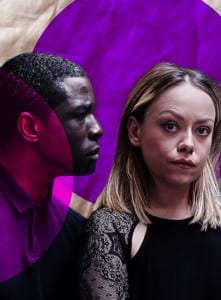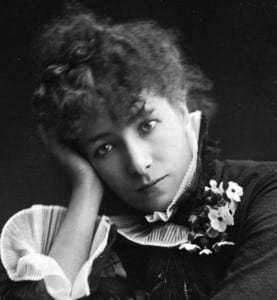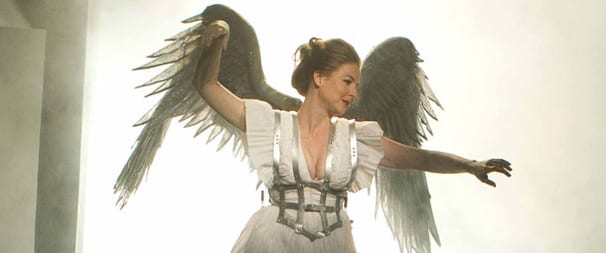This is an attempt to make sense of the nonsensical – to an eXTENT
For a better context and understanding of how to use this entry is that anything in bold is commentary whilst that in regular font is that of the script, anything boxed up is content from my reflections during the module at different points.
For some wide and overreaching analysis of where this project came from, it is an amalgamation of a very wide range of practitioners, writers, artists, contemporaries and snippets of our our process. We connected strongly with the factor that ‘Everything is a Remix’ and therefore attempting to attain an original would be superfluous in terms of a project as well as distancing ourselves unnecessarily from the module. This, along with our interest in blending the line between actor and character, or performer and performance gave us the primary sources of Eugene Ionesco, Rory Mullarkey, Will Eno, Peter Handke, Chris Goode, Tim Crouch and Simon Stephens.
Our attempt to include and introduce a number of ‘Current Issues’ within the performance was designed to be subtle and metaphorical instead of a blunt force implementation of a single factor. I was very keen to retain a semblance of narrative as the Eno approach of consistent construction and breakdown of the story or character is an emotionally evocative and draining experience. This is also effective at distancing the spectator from the actors, listening to the words and actions sans emotional attachment, to a degree.
With a nod to constant documentation, I wrote, at this stage, the initial ideas I had for our work:
The Chairs, Ionesco Interview, Will Eno – Thom Pain, Cannibals – Rory Mullarkey This is about loss. The loss of a memory. And as memory makes up you, as memory is all that you can remember, when you forget, does a part of you go with it? And as the memory fades, as does those all important visceral attachments to it. They become more sedated, more numb. Less important. Clear basis in ‘everything’s a remix’ Constant postmodern references to show the work in progress metaphor of the painting and the script itself. Serious consideration taken into scenographic elements and a high concentration on semiotics to display the correct message to the audience. Allegri – Miserere Mei, Deus Berkley, perception of food taste, cigarettes, colour are all mental perceptions as no one colour, taste can be nailed down. Perceptions change and therefore cannot be a constant from the object, rather a mental phenomenon presented by the individual. (Do a section on the paint colour, taste of a cigarette etc.) John Locke. A ‘sensible object’ Sound??
These may seem a little incoherent or inconsistent but I think is a real insight into our starting point, our springboard if you like into this performance process.
Placing the chair softly. No one is there. M and J prep the stage, moving around and shifting props.
Only two lines in! Well this concentration on the ’empty chair’ is a echo back to Ionesco’s Chairs where hundreds on invisible individuals join the old couple on stage, filling the empty stage with their non-existence. Also, as Roach and Rayner interestingly discuss, the empty chair is full of potential. Of what has been and what can be.
J: Would you please join us?
M: Are you sure?
J: Me? Yes of course.
M: It’s just…
J: What?
M: Nothing, it’s just… It’s just…
J: What.
M: How do you know they are right for it?
Here we aimed to set up the broken and conversational style of the piece. We also make no apology in attempting to include the audience. This has real connections to Eno’s Thom Pain: Based on Nothing in terms of its style.
J: I think that’s the whole thing. A special relation to language. People who, maybe, mistrust it in some big ways, but also know that it’s all they really have. There’s a sound to that kind of relation. You hear it almost instantly. It’s just a good balance of fear and need. Like, a kind of quavering, with authority. Probably, also, I think you have to be honest. Honest and humble. I think you have to say to yourself, here are the rules, here are the boundaries, and, within these limits, I will do everything I can to create an effect of infinity. [to the volunteer] And you are that. All of that, the whole thing.
This section is an edited and adjusted interview with Eno, discussing the necessity and intrigue in being a performer. We are inviting the member of the audience to fill this ultimately infinite role. Which is ridiculous..! However, again we are setting the context and style of the performance.
OK?
M: …and I don’t have that?
[J lifts her eyebrows]
M: Let me paint you
J: Okay
They look at each other
As long as it won’t take too long.
M: I promise it won’t. I only need you for the early work, so we can probably go straight through, but let me know anytime if you need to stop. I’ve plenty of food and you can rest in the bed anytime if you’re tired.
This is transposed straight from Mullarkey’s seminal Canibals. We enjoyed, upon first reading, the premise of the painter and the model. It has real metaphorical flexibility and buoyancy to carry a different message. We latched onto this as a portion of our breakable narrative.
OK…Now you sit.
J: Please sit.
M: Sit.
J: hank you. For… Thank you.
M: No need to thank me. We’re both doing things for each other.
J: I’m thanking you anyway.
M: Well I’ll thank you too, then, in that case.
J: This will be over quickly.
Do you want a drink?
Ignore them [audience]. They are nothing. Invisible. Just empty.
This last line is a little too obvious. It does, however connect a nice clear theory to performance! We choose to ignore the audience here but then are totally inclusive later on. That balance between fear and need…
Silence
M: I don’t want to confuse you
J: No
M: That wouldn’t help, not at all.
J: Like: he only lies
M: And: she only tells the truth.
J: Simple, but does the trick.
Pause.
This following section is again taken directly from Cannibals. The creating of a character, live on stage from the beginning albiet staged and scripted.
J: So who am I to be, then?
M: I think St Catherine. She was martyred in the early fourth century.
M goes to the computer and brings up googled examples of St Catherine. These can be wrong or incoherent choices. These are all live decisions.
It’ll be a hagigino… Hangong… [He turns and googles the word, allows google to speak it out loud then repeats] hagiographic icon, so there’ll be scenes from Catherine’s life around the outside: when she was tortured on the breaking wheel, for instance, or when she baptised the wife of the emperor Maxentius. There’ll be a main portrait in the centre through, a portrait of her, of you, so that’s what I need you to sit for. The scenes will show us some of the things she did, but the portrait will tell us who she really was.
More metaphor! We liked this content and context because it never comes to fruition or use. This is the most useless bit of information in the text. With hindsight, or a second viewing, this should be frustrating for the audience.
Contemporary Playwriting – Pornography
In relation to the rudimentary set-up of drama. Where do we place everyone?
B Ifor Evans. Historian etc. The Short History of English Drama
‘of the English theatre in the twentieth century, this at least can be said, that it is better than the English theatre of the nineteenth century’
19th C Theatrical desert. Worst period of drama. Panto, Vaudeville, melodrama – superficial theatre.
Not very auspicious, only just better than the worst.
The curfew of WW2 moved shows forward to 6, people went after work so no time to get changed which changed the composition of who went to the theatre.
Theatre consumer post war. interested in art but not interested in art in a deep or complex way.
UK is insulated from the avant garde. It isn’t seen as worthwhile. As it has no commercial place due to the bricks and mortar take of theatre.
Kenneth Tynan – First person to say fuck on a British stage. Provocative, highly intellectual. Love/hate figure.
George Devine, Artistic Director of the English Stage Company, first to bring the continental theatre over to the UK.
Royal Court becomes predominant theatre in the UK. The premier theatre of the 60’s ‘The Right to Fail’ – commonly attributed to Tony Richardson. ‘The writers theatre’
Joan Littlewood and Theatre Workshop – Research
Edward Bond brings down Theatre Censor 1965-68 since 1737
Theatre in the 60’s was an oppositional force – something that questioned both government policies and society’s underlying values.
Arguments for a Theatre – Barker
Stage Right – Jon Bull
Procrustean Bed – Fit evidence to your conclusion instead of using hte evidence to make your concculsion
Seems to think the exeriences of young people are the avenues worth following.
akira karsawa
‘inarticulate rage’
Pause
M: I can stop whenever.
Silence
At one time or another I used to have euphoric dreams; dreams in colour; this one which I had many years ago: I am walking through a brown forest, through long green grass, yellow light shining through the branches of the trees and at the end of the forest a luminous clearing where the colour met. Nothing else, save an ineffable joy. If at that time I had been preoccupied with my dreams, if I had tried to probe this dream, or rather to relive it, I might perhaps not have experienced it so fully; but that is what it was, earth and heaven interpenetrating one another, feeding one another and feeding me myself with vital sap. But alas, what that earth may be, what that light may be, that’s something I still don’t know, or rather something I…we no longer feel –
I have so much difficulty expressing myself…
It’s gone now. The light, the earth. I feel. I just don’t colour it as well as I used to. I’ve lost that. And I don’t know if I can get it back. Or perhaps they were never there. I…we’ll never know.
The section above is an amalgamation of Ionesco and myself. He wrote the basis of the dream and then I adjusted and moved sections to make it fit our premise a little better. We also introduce this constant correction from singular to plural: I to we. This acts as a breaker in the rhythm of the piece but also implements a concept constantly in the audience’s mind that this is a inclusive experience, that the actors are never alone in their work.
Silence
J: Do you want me to wear something?
M: There’s some clothes I use for models on the side. And take that stick, too. St Catherine is supposed to have a sword, but I don’t have a sword, so I’ll have to imagine one. The stick will be useful, though, to see how your hands clasp an object. I’ll wait outside for you to change. He goes. She looks around. She picks up a small icon and puts it into her pocket. She changes into the St Catherine clothes: a long, blue tunic and a belt. She waits.
J: And for the first time I…we hear human noises from the invisible crowd: bursts of laughter, muttering ‘shush’ing, ironic coughing. Faint at first, these sounds will grow before dying away. But ignore them. It’s passed.
M: Ready? She picks up the stick.
J: How should I hold this?
M: Like you would a sword. She holds the stick awkwardly. Don’t think about the way you’re doing it, just do it.
J: What?
M: Just try and clear your mind.
J: Yes. Just. Okay.
M: Do you feel it?
J: That was impressive. The dream, the way you told it. I listened and you told me…us.
M: You were impressive too. It is not mine, well it was. Not anymore.
J: Are you comfortable? That’s great. That’s really good. I’m doing really well. I was –
M: Inspired.
J: Considering we didn’t have time to finish before…[the audience]
Silence
Thank you for listening.
You can go now. Thank you again
M: Am I that?
J: Are we what?
M: What you said earlier. Are we that?
J: The whole thing? A special relation to language? No, that was Eno, not us.
M: But it feels true.
J: Of course, but it still isn’t me
M: Us
Pause
J: It still isn’t us.
M: She looks sad for a moment but then relaxes slightly. Good. Tell me something.
J: What?
M: Tell me something about you.
J: Erm…
M: Tell me about your life. If I understand your life, it will help me understand you, and I can try and put it in the painting.
Pause
Anything. Just start with the smallest things.
This was designed to break down and rebuild to break down again the feeling or notion of narrative, character or any other particular Aristotelian concepts of story. This was also placed here to crack the rhythm that had been previously built naturally from Jasmine and myself being Western performers.
J: The ridgeline stretched across my vision. forcing my horizon up up up then down to the cross. In the ground. The calluses are gone but the pain remains. They’re only shadows now. Reaching as the sun spreads. The colours playing tricks with my mind. There are less trees than there used to be, patchy across the hills. They seem less imposing, less overwhelming less, well… The leaves are still there. That hasn’t changed. They’ve seen the world, yawning to the sun every day. The path has shrunk as well. Flattened by stamps and carts, footfall, feeling the rock, the…
This is where we first introduced the only semblance of narrative. The word “rock” and what it stands for becomes more apparent but this is it’s first outing.
Sorry. That’s not really the smallest thing.
M: It’s fine.
J: No, I should have started smaller. It’s too easy just to jump in on your first impulse.
M: Impulse is good though. You were saying about a rock?
The section below returns to Cannibals. We relive and probe into the memory, building up a character backstory. Feeding life into the performer and into the audiences ability to suspend disbelief as we are offering this as an option to them.
Ok I was born on a farmstead about 4 days walk from here.
I don’t know how long ago, for some reason no one told me it was important to keep count.
I don’t remember them too much about my parents except my mother was fall that my father was short
From my childhood,
M: you remember lying outside in the shade in the forest looking up at some branches above my head.
You remember throwing a ball
You remember running down a track
You remember falling and cutting my leg on the palms of my hands, crying.
You remember night when I was scared of the dark and I couldn’t sleep.
I remember thinking it was darker in the room than when I close my eyes.
I remember a bull, a big one, snorting at me as I passed it field.
You remember my mother crying in the night.
You remember my baby brother dying and helping my father to dig a hole at the far end of our field.
Together: You remember thinking it might be selfish of me to be reassured by her crying but it stopped me being scared of the dark.
J: You remember a man coming to the house and talking to my parents.
You remember he smelled of potatoes and then he left.
You remember he came back again and took me with him to a farm on the other side of the Valley.
You remember the farm on the other side of the Valley was exactly the same as mine except smaller and on the other side of the Valley.
You remember he picked me up in his arms through me up up up and down onto the bed.
Recording of a girl speaks the following lines. M moves over to the computer to cue the sound, in full view of the audience.
You remember he promised not to touch me until I was older.
You remember he kept his promise and I was glad.
You remember he showed me how to chop vegetables and to feed the chickens.
You remember he was the milk the cows.
You remember he told me my parents are dead now and I only had him but that felt ok.
You remember he did touch me in the night and it hurt at first but then it didn’t and then I did again.
I didn’t bleed and then I did and then I didn’t.
I rub my feet. To hurt all the time and I was worried I was getting fat.
You remember I went to an old woman at the valleys over and she told me what was happening.
She told me that I should rest a lot and that I shouldn’t drink vodka and that I should be wary of losing my footing in places with sharp jagged rocks.
M hands out a script to two random audience members, one reads as A one reads as B.
Despite the construction of the narrative and character, we pass the onus onto the audience to continue the story and character. This adjusts the premise, offering them control to where and how we receive the information, it directly feeding into the physical element of this part of the performance.
A: You remember I lay on my back every night terrified I would roll onto my front in my sleep
B: You remember one afternoon I went outside to fetch the milk pail after my husband had gone to the market
A: You remember I felt something split and push inside me and I bent forward suddenly and dropped my pale and the milk ran down the path and mingled with the mud at the edge of the grass.
B: You remember I called out several times for my husband but then, you remember, you remembered he was out at the market.
A: You remember I went inside slowly and took a sheet off the bed and spread it on the floor
B: You remember I straighten it out with my feet before I squatted down and that when I squatted down my calves hurt because I haven’t done it for a while
A: You remember my knees what up around my ears and I scrutinised the door frame very hard
B: I felt something push inside and I pushed back against it
A: You remember I pushed and it started to hurt
B: You remember I pushed and it hurt more than ever before but I knew it was worth it
A: You remember I pushed and I look through the window at the sun on the trees on the ridgeline
B: You remember I pushed and I felt opened up from my crown to my toes
A: You remember I pushed and my toes made a fist on the floor
M and J are knelt facing each other on the bed. Each time M says ‘You remember’ he hits her in the face. When J responds, she hits him in the face too.
This section is again taking directly from Cannibals. It also draws huge amounts of inspiration from Marina Abramovic and her piece Light/Dark. Which also makes use of the visceral act of striking another human.
Postmodernity, Mediatised and Global Cultures
Malpas is a really good primer for postmodernism (99-2000) Good read for this subject.
Bourriad has more a conceptual basis in life rather than theatrical
Postmodernism (in art) postmodernity, two very different things.
Postmodernism in art is a bit more straightforward. Modernism was a more structured and ‘placed’. A comparative backtrack to modernism is a good way to relate and understand postmodernism.
Modernism, post WW1. A Grand Narrative. In art, control, rigor, technique, order.
Modernism formalises after WW1. Seeded in Victorian era. Process of rebuilding from 20’s onwards.
Postmodernism, the post is misleading as it doesn’t necessarily come after the modern. WW1 is the first ‘ripping’ and entrance into modernism.
Dada movement, second wave surrealist.
In art, ‘the idea in art’, postmodern – ‘the process’
Modernism, clarity, nothings wasted. Postmodern, perfection of pointlessness, ornament. Postmodern. Faux Tudor.
Process is, at the very least on a level to the product. Wooster group.
The feeling I’m getting is that Postmodernism in art seems to be reactive to modernism as opposed to an attempt to create something new.
Postmodern (philosophical)
constitutes a doubt about the relationships between parts and whole.
Epistemic certainty. – How do I know that I know what I know. An inherent contradiction. The theory that denies theory
parts and wholes..
Concepts are what mediate between you and the world – Kant refers to it a synthesis.
Understanding concepts is what helps synthesise. The pretend to unify things into wholes. Kant – Synthesis of the Manifold.
Concepts aren’t given, aren’t innate. Concepts are not raw data, they are constructs. Descartes proposed that the ‘self’ is free from those kinds of barriers. That I am ‘given to myself’ directly.
If I doubt everything, I might get an answer to something!
Postmodernism says that this is not the case but that we are in face ‘decentered’ from ourselves. But how?
‘The limits of my concepts are the limits of my world’ (kind of Liechtenstein)
Doubt about the centrality of the self, about the centre of the self in the world. Doubt about the world as it is, about the reality, the truth of that. Relative perception. Fundementally tied to a doubt around concept. Instability of a concept. COncept belongs to a network of other concepts. Shared understanding shift and move in relation to language, social structue etc. Like a sea of marbles.
Postmodern thought isn’t always self reflective. We are actually trying to achieve something in postmodern philosophy. It isn’t just relativism. There is something to achieve.
Notion of the original is thrown into doubt.
As a concept it is unstable.
gabbans and method
On a personal level, this was an incredibly moving and terrifying section of the performance. It had so much in terms of passion and emotion that this truly (and I don’t speak this way to make an academic point) did blend the line between performance and performer. I could not tell if Jasmine was genuinely hurt or that she was covering her own emotions which characterisation. This left me in a very difficult and confused situation where my own position on stage and identity as a performer was questioned as I was not sure if, at any time, I was sharing the same liminal position of performativity as my stage partner, a misalignment would also not academically work to our advantage.
You remember I pushed and pushed with a quick in my neck You remember I pushed as I screwed up the sheets with my feet You remember I pushed and it hurt You remember I pushed and it was worth it You remember I pushed and it hurt You remember I pushed it was worth it You remember it was worth it You remember I pushed You remember I pushed You remember I pushed You remember I pushed You remember I pushed You remember I pushed You remember I pushed You remember I pushed I remember I pushed You remember I pushed my remember I
You remember I was told it supposed to cry
You remember I was told it supposed to move
It’s supposed to breathe at least
You remember that
It isn’t a child if it isn’t alive
It isn’t a son or daughter
So what is it then a Blob, a rock a rock a rock a rock a rock a rock a rock
M: I looked out of the window
J:Can you put that in? Can you put that in the painting?
This monologue was written last and is woefully, crassly biographical. This was our narrative swansong, offering a final nod to consistency and linear character. This section is heavily influenced by the writings of Will Eno in his opus Thom Pain: Based on Nothing where he sublimely contorts the line between performer and performance to the extent that you are mentally exhausted by keeping up with the truth and the lies, the honesty and the created.
M: [Sitting in the now vacant chair] I struggle constantly. Not constantly but it comes in waves. You know, like a cold sweat in the middle of a balmy night. Like a heart drop when you remember.. And it’s not so much a struggle as a worry. A wavering worry. A fear that something is… That everyone can… That I am not as good as I think I am. Some might see that as humbling or a necessary dampening of ego but it’s disheartening and I get these urges to scream. A scream so deep, so loud and so freeing that my throat burns, burns for days. Hurts to swallow. I want to scream. I want to scream, tear my shirt off, smash through the window and run until my legs burn, the sweat stinging my eyes, run till my legs are numb and the steam emanates off my face, because if I lose this, well, I loose it all, then I’ll run further and my legs collapse and the sweat evaporates. Then I’ll.. [Maybe finding a place on the ground, trying to find the panting or painting, or neither] Well I never got this far so I don’t know what would come next. Maybe I’d vomit, maybe I’d quietly cry to myself or to a passing stranger. Or I’d shun comfort and put on a brave face, or just lie in the middle of the road, sweating, panting, letting the worry steam off me. [Sitting up, maybe] Or I’d imply a slight discomfort overtly in the presence of others with a quiet sigh and keep my struggle, and keep my running, and keep my screaming and keep my tears to myself. St. Catherine wouldn’t smoke… I’ll edit it out later. This isn’t finished either. I’ll cut and move bits around to make it gel better later..
J: Go to sleep.
[Moves over to the bed]
M: It’s getting there though. I really think we’re on to something, J.
[Collapses into the position of Jesus in Michelangelo’s Pietà]
This was another nice, aesthetically fun image to quickly create. It also contains a huge amount of ghosting for my own past of performances. This Pietà and my position as Jesus holds an emotional connection to a very important previous show I took part in which jolted and shifted my perception of performance and acting.
Postdramatic Theatre
Playwriting, Scripting and Devising
21st November – debbie tucker-green symposium?
Postdramatic Theatre – Hans-Thies Lehmann (2006) Writing from a european context. It is an analytical survey of 150 of european theatre.
Discussing industrial revolution forward in terms of theatre.
Lehmanns case studies were works from the 1970’s
He is driving a wedge between the concepts of theatre and drama.
The deconstruction and dissemination between Aristotelian theories of drama and the new.
There are some forms or paradigms that no longe can be understood bythe conventions of the past. They entertain a relationship to drama’s they were ‘birthed’ from the past.
Aesthetic logic – Received critical mass and now, instead of this postmodernism being seen as alongside art, it can now have its own concept and term as of 40 years ago.
Ability to digest information has changed.The internet, magazines etc.
PM is the larger contextual term, culturally. Post-dramatic is the finer tool to analyse theatre and drama.
Drama, traditionally interchangable with Aristotle
Silence
J: He talks too much. It’s ok. We can change it though. Change him. Change it.
[She stands and walks over to the ‘painting’]
J: I don’t think he’s really a painter at all. There’s no easel here for a start, no canvas. Just a paintbrush and the warm air of the stage. But I can see it. I can see what he was painting. I can see it in my mind. I remember that, it’s mine and he made that for me. For us.
[She moves over to the bed and lays on top of the covers, happy.]
[Lights fade out.]







